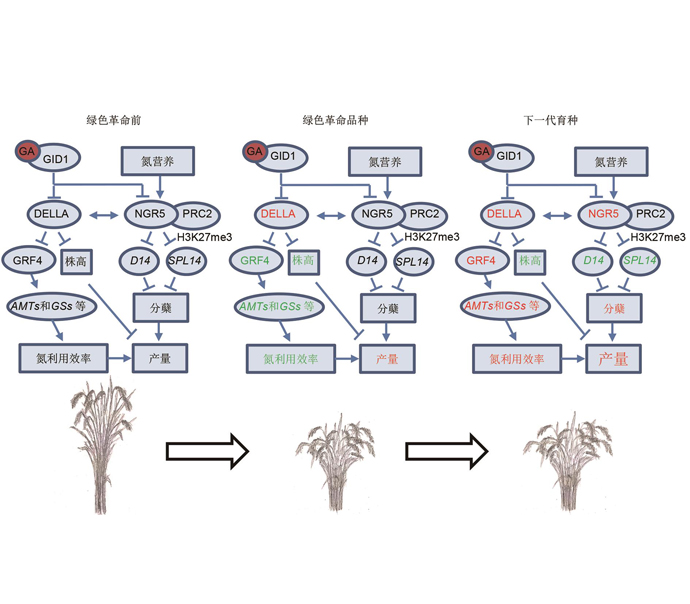

“绿色革命”新进展: 赤霉素与氮营养双重调控的表观修饰助力水稻高产高效育种
收稿日期: 2020-01-07
录用日期: 2020-01-13
网络出版日期: 2020-02-07
基金资助
国家重点研发计划(2016YFD0100700)
A New Progress of Green Revolution: Epigenetic Modification Dual-regulated by Gibberellin and Nitrogen Supply Contributes to Breeding of High Yield and Nitrogen Use Efficiency Rice
Received date: 2020-01-07
Accepted date: 2020-01-13
Online published: 2020-02-07
以半矮秆育种为代表的“绿色革命”极大地提高了作物产量, 但也带来氮营养利用效率降低的严重问题。“绿色革命”主要基于调控赤霉素的代谢和信号转导而实现。前期的研究发现, 赤霉素信号转导关键因子DELLA蛋白通过调控GRF4而负调控氮素的吸收利用, 为半矮秆品系氮利用效率低的问题提供了解决方案。最近的一项研究进一步揭示了GA信号途径与氮响应交叉互作的新机制。该研究发现水稻(Oryza sativa) NGR5是氮素调控分蘖数目的一个关键基因, 其表达受氮诱导。通过招募PRC2, NGR5对D14和OsSPL14等分蘖抑制基因所在位点进行H3K27me3甲基化修饰, 从而抑制其表达。而在半矮秆背景下超表达NGR5可以提高低氮水平下的水稻产量。NGR5同时也被发现为赤霉素受体GID1的一个新靶标, 受到其负调控。该研究发现了调控赤霉素信号通路的新机制, 并对高产高效的新一代“绿色革命”育种实践具有重要启示。

韩美玲 , 谭茹姣 , 晁代印 . “绿色革命”新进展: 赤霉素与氮营养双重调控的表观修饰助力水稻高产高效育种[J]. 植物学报, 2020 , 55(1) : 5 -8 . DOI: 10.11983/CBB20002
The Green Revolution represented by the breeding of semi-dwarf crops greatly promoted agriculture yield, but it also unfortunately led to the problem of low nitrogen use efficiency (NUE). The achievement of Green Revolution was mainly based on modification of gibberellin (GA) metabolic or signaling pathways in crops. A previous study has found that the central regulator of GA signaling pathway DELLA protein negatively regulates NUE through suppressing GRF4, an essential NUE regulator, which provided a resolution for improving NUE of semi-dwarf rice. A recent study further revealed a novel mechanism underlying the crosstalk between GA signaling and nitrogen response. The study revealed that NGR5 is a key gene controlling tiller number changes under different nitrogen conditions, which is inducible by nitrogen. Further investigation established that the NGR5 suppresses branching inhibitory genes, such as D14 and OsSPL14, through nitrogen-dependent recruitment of polycomb repressive complex 2 that promotes histone H3 lysine 27 tri-methylation in the regions habouring the branching suppressors. In addition to be responsive to nitrogen, NGR5 is also negatively regulated by GA and its receptor GID, and overexpression of NGR5 in the semi-dwarf background is thus able to significantly improve rice yields under low nitrogen conditions. This study not only uncovered a new mechanism of GA signaling, but also enlightens the new generation of Green Revolution by breeding high yield crops with enhanced NUE.

Key words: rice; tiller number; nitrogen use efficiency; histone modification
| [1] | Crawford NM, Forde BG (2002). Molecular and developmental biology of inorganic nitrogen nutrition. Arabidopsis Book 1, e0011. |
| [2] | Gooding MJ, Addisu M, Uppal RK, Snape JW, Jones HE (2012). Effect of wheat dwarfing genes on nitrogen-use efficiency. J Agric Sci 150, 3-22. |
| [3] | Guo JH, Liu XJ, Zhang Y, Shen JL, Han WX, Zhang WF, Christie P, Goulding KWT, Vitousek PM, Zhang FS (2010). Significant acidification in major Chinese crop- lands. Science 327, 1008-1010. |
| [4] | Harberd NP, Belfield E, Yasumura Y (2009). The angiosperm gibberellin-GID1-DELLA growth regulatory mechanism: how an "inhibitor of an inhibitor" enables flexible response to fluctuating environments. Plant Cell 21, 1328-1339. |
| [5] | Khush GS (1999). Green Revolution: preparing for the 21st century. Genome 42, 646-655. |
| [6] | Kong WD, Zhu YG, Fu BJ, Han XZ, Zheng L, He JZ (2008). Effect of long-term application of chemical fertilizers on microbial biomass and functional diversity of a black soil. Pedosphere 18, 801-808. |
| [7] | Li S, Tian YH, Wu K, Ye YF, Yu JP, Zhang JQ, Liu Q, Hu MY, Li H, Tong YP, Harberd NP, Fu XD (2018). Modulating plant growth-metabolism coordination for sustainable agriculture. Nature 560, 595-600. |
| [8] | Murase K, Hirano Y, Sun TP, Hakoshima T (2008). Gibberellin-induced DELLA recognition by the gibberellin receptor GID1. Nature 456, 459-463. |
| [9] | Peng JR, Richards DE, Hartley NM, Murphy GP, Devos KM, Flintham JE, Beales J, Fish LJ, Worland AJ, Pe- lica F, Sudhakar D, Christou P, Snape JW, Gale MD, Harberd NP (1999). 'Green Revolution' genes encode mutant gibberellin response modulators. Nature 400, 256-261. |
| [10] | Pingali PL (2012). Green Revolution: impacts, limits, and the path ahead. Proc Natl Acad Sci USA 109, 12302-12308. |
| [11] | Sasaki A, Ashikari M, Ueguchi-Tanaka M, Itoh H, Nishimura A, Swapan D, Ishiyama K, Saito T, Kobayashi M, Khush GS, Kitano H, Matsuoka M (2002). Green Revolution: a mutant gibberellin-synthesis gene in rice. Nature 416, 701-702. |
| [12] | Sasaki A, Itoh H, Gomi K, Ueguchi-Tanaka M, Ishiyama K, Kobayashi M, Jeong DH, An G, Kitano H, Ashikari M, Matsuoka M (2003). Accumulation of phosphorylated repressor for gibberellin signaling in an F-box mutant. Science 299, 1896-1898. |
| [13] | Shimada A, Ueguchi-Tanaka M, Nakatsu T, Nakajima M, Naoe Y, Ohmiya H, Kato H, Matsuoka M (2008). Structural basis for gibberellin recognition by its receptor GID1. Nature 456, 520-523. |
| [14] | Spielmeyer W, Ellis MH, Chandler PM (2002). Semidwarf (sd-1), "green revolution" rice, contains a defective gibberellin 20-oxidase gene. Proc Natl Acad Sci USA 99, 9043-9048. |
| [15] | Wu K, Wang SS, Song WZ, Zhang JQ, Wang Y, Liu Q, Yu JP, Ye YF, Li S, Chen JF, Zhao Y, Wang J, Wu XK, Wang MY, Zhang YJ, Liu BM, Wu YJ, Harberd NP, Fu XD (2020). Enhanced sustainable Green Revolution yield via nitrogen-responsive chromatin modulation in rice. Science 367, eaaz2046. |
| [16] | Zhang CH, Gao LF, Sun JQ, Jia JZ, Ren ZL (2014). Haplotype variation of Green Revolution gene Rht-D1 during wheat domestication and improvement. J Integr Plant Biol 56, 774-780. |
/
| 〈 |
|
〉 |